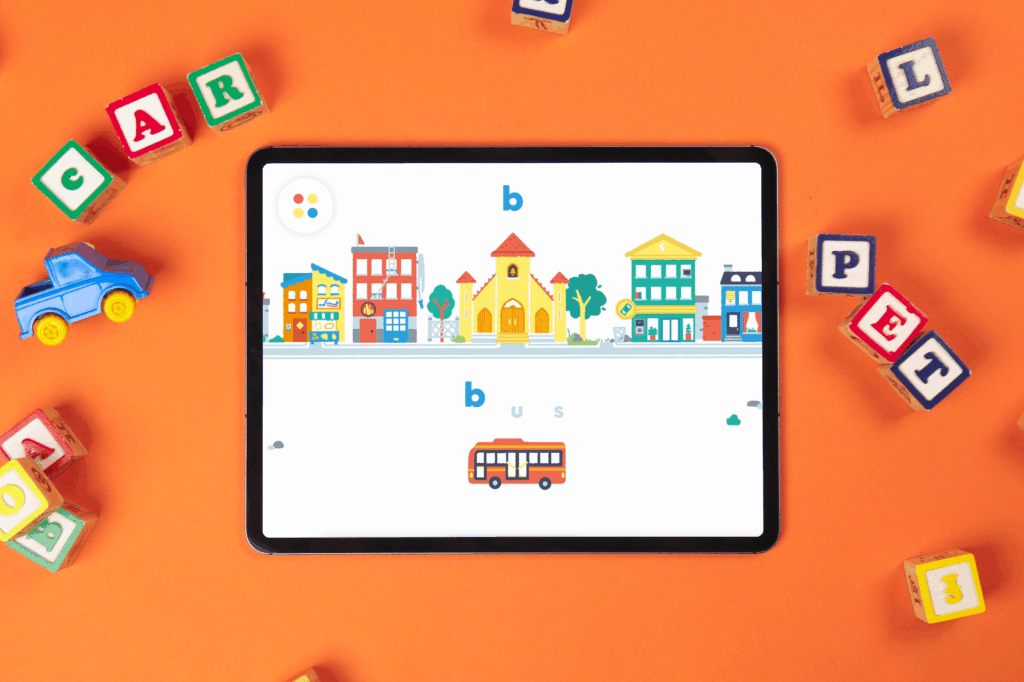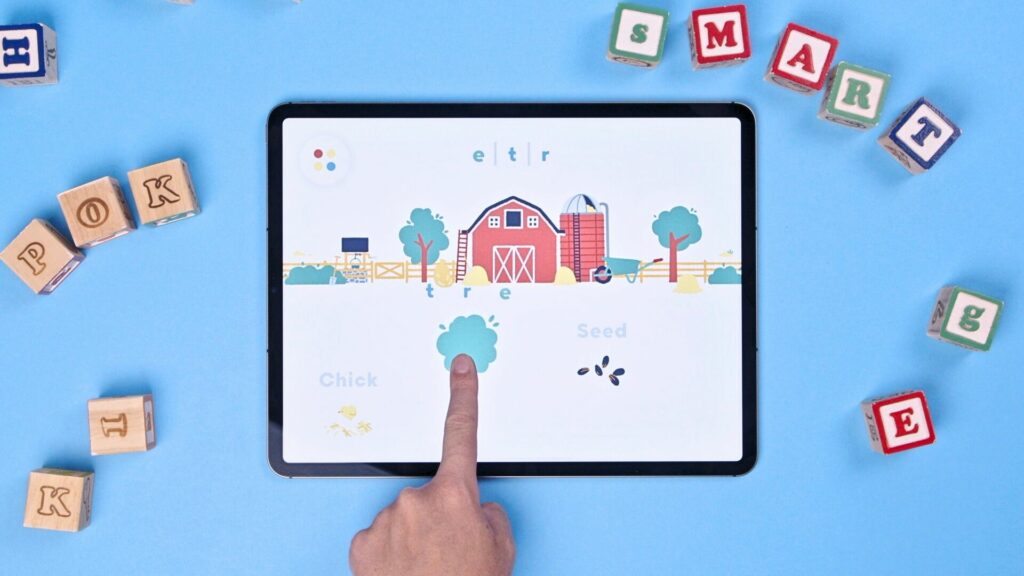New Toy: Phonics
How (and why) we’re bringing language into Pok Pok.
We’re doing something we’ve never done before in the Pok Pok app—introducing language! Over the past couple of years, we’ve noticed that our community has grown eager for us to explore more traditionally academic subjects, but “Pok Pok-ified” through our unique lens.
Part of doing things the “Pok Pok way” is fostering abilities, rather than the regurgitation of information. With the guidance of speech language pathologist advisors like Amy Levin, we’ve created a toy that doesn’t just ask kids to memorize words or spelling, it helps build a foundational understanding of language. In Phonics, they practice connecting sounds to letters so they can decode and create words. If you’ve ever asked a child to “sound it out”, this refers to that decoding process!
Before working with Amy as an advisor on Phonics, she’d already been using Pok Pok with clients in our 2-8 age range. When asked why she chose Pok Pok for sessions, she shared that:
- A strength of Pok Pok is that it doesn’t demand a single “right answer” from kids. When kids feel like they are being tested, they are less likely to be engaged or motivated. Instead, Pok Pok supports and rewards exploration.
- The app also gives adults a way to engage with kids around screen time and communication, bridging a gap where there may have been a lack of confidence in their approach.
- The interactivity of Pok Pok offers an opportunity to talk about what is happening, not just the object itself. This sparks more organic and fruitful language use. (Busy Book is a stand-out toy for this!)
So while Phonics is focused specifically on building and decoding words, any toy in Pok Pok that intrigues your child can help develop language!

Why Is Phonics So Important?
Phonics is a research-backed method that helps kids learn to read by focusing on the sounds within words, not just how words look on a page. For instance, the word “ship” would be understood as having 3 phonemes: /sh/ /i/ /p/. Having this working knowledge of words and their building blocks helps little ones:
- Break words into smaller, manageable sounds
- Blend those sounds into full words
- Improve spelling with an awareness of phonemes
- Build confidence and enjoy reading/writing more, since they get stuck less
By starting with phonemic awareness (how words sound and how letters represent sounds), kids gain the foundation they need for strong reading and writing skills later on. While the words in the toy may not match standard spelling until it’s revealed upon completion, it is more important for children to grasp the sounds first and improve spelling later.
When we asked Amy about whether kids should learn the correct spelling alongside the phonics, she explained that,
“Learning sound-letter relationships, recognizing those sounds in words, and manipulating letters to write sounds in words are all developmental and constructive processes. We expect that children will use inventive and developmental spelling while they continue to build and strengthen their knowledge of these foundational skills.
This developmental spelling can be a window into how they are learning and understanding all the visual and auditory information that is important for reading and writing in the early years. The Phonics toy gives children the opportunity to use the knowledge that they have and also get consistent models and encouragement to make the connections to ‘correct’ and conventional spelling.”
Phonics vs. Whole Language
Reports from all around the world have recommended phonics over another widely used approach: whole language learning. The latter aims for kids to learn to read through context clues, and notice how to match sounds to letters (and vice-versa). This can look like a teacher focusing on the images in the book, encouraging kids to predict what comes next, act it out, or brainstorm with their peers.
The whole language method assumes children will “soak up” reading like they do spoken language, but reading is not natural in the same way speaking is. While the whole language focus on experiential learning and meaning-making has lovely elements, it actually leaves a lot of learners behind. This is reflected by the literacy rates through peak periods of whole language use.

How To Play
The design and flow of this new toy may feel similar to Number Journey, our counting toy that we released in the fall of 2024. As you open Phonics, you will be greeted with a fun scene full of familiar objects and characters. These everyday people, places, and things make it easier for kids to connect words with the world around them!
- To start: Much like Number Journey, kids can drag the letter units representing the sounds (graphemes that represent phonemes) from the top to complete a word for the object shown below.
- The boxes below are “elkonin boxes”, which help give visual structure to the segmentation of sounds. Each sound can be heard as kids play, and blending the sounds creates full words for a hands-on learning experience.
- Completed words stay on the screen, encouraging kids to revisit and practice them naturally.
- Vowels and diphthongs: To distinguish vowels and diphthongs (a combo of 2 vowel sounds) from consonants, they will appear green. This is an extra layer of depth that is subtle enough to blend in, while offering more learning for kids who are ready.
- Engaging Sound Design: Kids can tap letters to hear their sounds, swipe across graphemes to hear blended sequences, or listen to words spoken in full.
- Adaptive Challenges: Puzzles gradually increase in complexity. Some offer helpful hints, while others introduce playful word chains to spark curiosity and discovery.
We are so excited to see how your children play with Phonics and hear your observations as a parent. Are they sounding words out? Did it inspire conversations with the family? We hope that it not only sparks learning but also a deep curiosity for language! Please tag us at @playpokpok if you share any captures on social media, or message us there with any questions.
P.S. You can use this link to prompt the update on your child’s device if the update has not happened automatically.
We’ve been so inspired by the unique approach of each child who plays with our toys and can’t wait to hear what families like yours think of this one. Receiving your feedback, videos and ideas for new updates is so important for the growth of Pok Pok so please say hello at hello@playpokpok.com or on social media @playpokpok.










